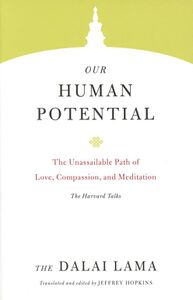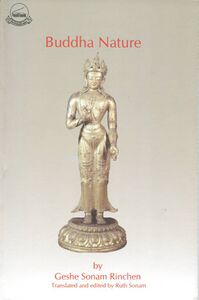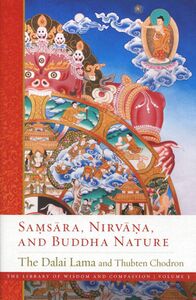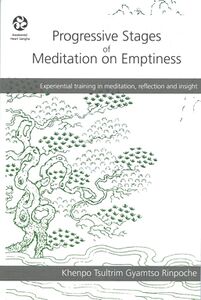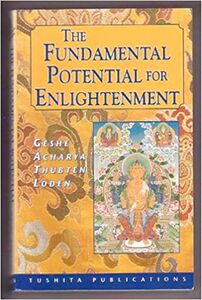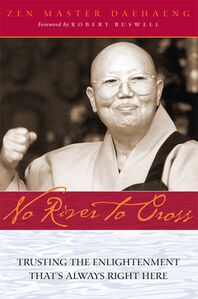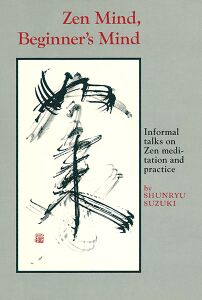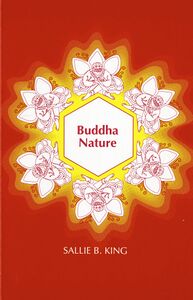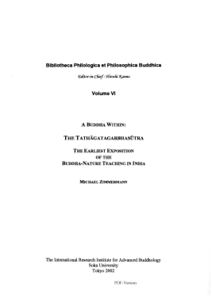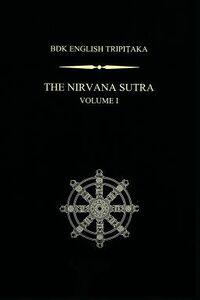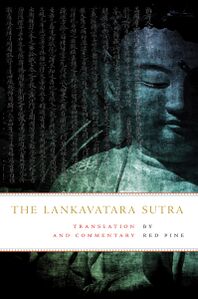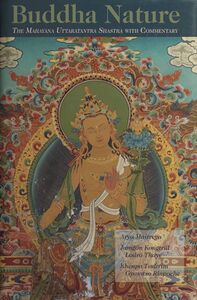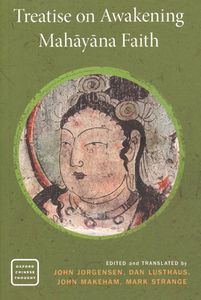Begin Discovering Your Buddha-Nature: Difference between revisions
From Buddha-Nature
No edit summary |
M.Koblensky (talk | contribs) m (Text replacement - "commons.tsadra.org/images-commons" to "commons.tsadra.org/images") |
||
| Line 24: | Line 24: | ||
|link=Media/We_Are_Enlightened_by_Nature | |link=Media/We_Are_Enlightened_by_Nature | ||
|header=We Are Enlightened by Nature | |header=We Are Enlightened by Nature | ||
|image=https://commons.tsadra.org/images | |image=https://commons.tsadra.org/images/d/d6/Dzigar_Kongtrul_Rinpoche_Mangala_Shri_Bhuti.jpg | ||
|content=Dzigar Kongtrul Rinpoche provides encouragement that we are all enlightened by nature, and the path is a process of discovering that enlightened nature. | |content=Dzigar Kongtrul Rinpoche provides encouragement that we are all enlightened by nature, and the path is a process of discovering that enlightened nature. | ||
|watermark=Video | |watermark=Video | ||
| Line 32: | Line 32: | ||
|link=Media/Discovering_Buddha_Nature:_Talk_by_Yongey_Mingyur_Rinpoche | |link=Media/Discovering_Buddha_Nature:_Talk_by_Yongey_Mingyur_Rinpoche | ||
|header=Discovering Buddha Nature: Talk by Yongey Mingyur Rinpoche | |header=Discovering Buddha Nature: Talk by Yongey Mingyur Rinpoche | ||
|image=https://commons.tsadra.org/images | |image=https://commons.tsadra.org/images/b/bc/YMR_LamaYadi_LamaTrinley_KhenpoKunga_0534_FLT-1.jpg | ||
|content=Mingyur Rinpoche describes buddha-nature with the metaphor of a diamond covered in mud, explaining how the innate purity of awareness can be obscured, but never changed. | |content=Mingyur Rinpoche describes buddha-nature with the metaphor of a diamond covered in mud, explaining how the innate purity of awareness can be obscured, but never changed. | ||
|watermark=Video | |watermark=Video | ||
| Line 40: | Line 40: | ||
|link=Media/Dealing_with_Depression:_Interview_with_Jetsunma_Tenzin_Palmo_on_Study_Buddhism | |link=Media/Dealing_with_Depression:_Interview_with_Jetsunma_Tenzin_Palmo_on_Study_Buddhism | ||
|header=Dealing with Depression: Interview with Jetsunma Tenzin Palmo on Study Buddhism | |header=Dealing with Depression: Interview with Jetsunma Tenzin Palmo on Study Buddhism | ||
|image=https://commons.tsadra.org/images | |image=https://commons.tsadra.org/images/8/82/Jetsunma_Tenzin_Palmo.jpg | ||
|content=Jetsunma Tenzin Palmo discusses buddha-nature beautifully for a general audience. | |content=Jetsunma Tenzin Palmo discusses buddha-nature beautifully for a general audience. | ||
|watermark=Video | |watermark=Video | ||
| Line 48: | Line 48: | ||
|link=Media/What_Is_Buddha-Nature%3F_by_Wulstan_Fletcher | |link=Media/What_Is_Buddha-Nature%3F_by_Wulstan_Fletcher | ||
|header=What Is Buddha-Nature? by Wulstan Fletcher | |header=What Is Buddha-Nature? by Wulstan Fletcher | ||
|image=https://commons.tsadra.org/images | |image=https://commons.tsadra.org/images/thumb/d/d1/Fletcher%2C_Wulstan-2014new.jpg/490px-Fletcher%2C_Wulstan-2014new.jpg | ||
|content=Wulstan Fletcher explains buddha-nature as the deepest aspect of oneself, a wellspring of goodness and wisdom that is always present. | |content=Wulstan Fletcher explains buddha-nature as the deepest aspect of oneself, a wellspring of goodness and wisdom that is always present. | ||
|watermark=Video | |watermark=Video | ||
| Line 56: | Line 56: | ||
|link=Media/On_How_Beginning_Students_Might_Engage_with_Buddha-Nature_Teachings_by_Ringu_Tulku | |link=Media/On_How_Beginning_Students_Might_Engage_with_Buddha-Nature_Teachings_by_Ringu_Tulku | ||
|header=On How Beginning Students Might Engage with Buddha-Nature Teachings by Ringu Tulku | |header=On How Beginning Students Might Engage with Buddha-Nature Teachings by Ringu Tulku | ||
|image=https://commons.tsadra.org/images | |image=https://commons.tsadra.org/images/c/cf/Ringu_Tulku-267x358.jpg | ||
|content=Ringu Tulku talks about how beginning students might start to orient themselves toward buddha-nature teachings in practice. He explains that it is important to recognize that everybody has the seed of wisdom and compassion within them. | |content=Ringu Tulku talks about how beginning students might start to orient themselves toward buddha-nature teachings in practice. He explains that it is important to recognize that everybody has the seed of wisdom and compassion within them. | ||
|watermark=Video | |watermark=Video | ||
| Line 64: | Line 64: | ||
|link=Media/Buddha_Nature:_What_is_it?_How_is_it_different_from_soul?_A_Teaching_from_Zasep_Tulku | |link=Media/Buddha_Nature:_What_is_it?_How_is_it_different_from_soul?_A_Teaching_from_Zasep_Tulku | ||
|header=Buddha Nature: What Is It? How Is It Different from soul? A Teaching from Zasep Tulku | |header=Buddha Nature: What Is It? How Is It Different from soul? A Teaching from Zasep Tulku | ||
|image=https://commons.tsadra.org/images | |image=https://commons.tsadra.org/images/c/cd/Zasep_Tulku-Vimeo.jpg | ||
|content="Everyone has Buddha Nature," explains H.E. Zasep Tulku Rinpoche in a "learning from the Teachers" video on the topic from BuddhaWeekly. | |content="Everyone has Buddha Nature," explains H.E. Zasep Tulku Rinpoche in a "learning from the Teachers" video on the topic from BuddhaWeekly. | ||
|watermark=Video | |watermark=Video | ||
| Line 72: | Line 72: | ||
|link=Media/Dzongsar_Jamyang_Khyentse_Rinpoche_Talks_about_Buddha-Nature | |link=Media/Dzongsar_Jamyang_Khyentse_Rinpoche_Talks_about_Buddha-Nature | ||
|header=Dzongsar Jamyang Khyentse Rinpoche Talks about Buddha-Nature | |header=Dzongsar Jamyang Khyentse Rinpoche Talks about Buddha-Nature | ||
|image=https://commons.tsadra.org/images | |image=https://commons.tsadra.org/images/5/57/Khyentse_Dzongsar_Wikipedia.jpg | ||
|content=Dzongsar Jamyang Khyentse Rinpoche talks about buddha-nature and offers a brief guided meditation. | |content=Dzongsar Jamyang Khyentse Rinpoche talks about buddha-nature and offers a brief guided meditation. | ||
|watermark=Video | |watermark=Video | ||
| Line 80: | Line 80: | ||
|link=Media/Matthieu_Ricard:_Is_Buddha-Nature_a_Seed_to_Be_Cultivated_or_Something_that_Must_Be_Revealed%3F | |link=Media/Matthieu_Ricard:_Is_Buddha-Nature_a_Seed_to_Be_Cultivated_or_Something_that_Must_Be_Revealed%3F | ||
|header=Matthieu Ricard: Is Buddha-Nature a Seed to Be Cultivated or Something that Must Be Revealed? | |header=Matthieu Ricard: Is Buddha-Nature a Seed to Be Cultivated or Something that Must Be Revealed? | ||
|image=https://commons.tsadra.org/images | |image=https://commons.tsadra.org/images/c/cf/Ricard%2C_M..jpg | ||
|content=In an excerpt from "Conversations on Buddha-Nature" with Lopen Dr. Karma Phuntsho, Matthieu Ricard answers this common question. | |content=In an excerpt from "Conversations on Buddha-Nature" with Lopen Dr. Karma Phuntsho, Matthieu Ricard answers this common question. | ||
|watermark=Video | |watermark=Video | ||
| Line 88: | Line 88: | ||
|link=Media/Karmapa_on_The_Nature_of_All_Beings | |link=Media/Karmapa_on_The_Nature_of_All_Beings | ||
|header=The 17th Karmapa on the Nature of All Beings | |header=The 17th Karmapa on the Nature of All Beings | ||
|image=https://commons.tsadra.org/images | |image=https://commons.tsadra.org/images/4/4c/Ogyen_Trinley_Dorje_Portrait-WikiCommons.jpg | ||
|content=H.H. the 17th Karmapa, Ogyen Trinley Dorje, comments on a quote of the 3rd Karmapa, Rangjung Dorje: "The nature of all beings is always Buddha" (འགྲོ་བའི་རང་བཞིན་རྟག་ཏུ་སངས་རྒྱས་). | |content=H.H. the 17th Karmapa, Ogyen Trinley Dorje, comments on a quote of the 3rd Karmapa, Rangjung Dorje: "The nature of all beings is always Buddha" (འགྲོ་བའི་རང་བཞིན་རྟག་ཏུ་སངས་རྒྱས་). | ||
|watermark=Video | |watermark=Video | ||
| Line 96: | Line 96: | ||
|link=Media/The_Fourteenth_Dalai_Lama_on_Buddha-Nature | |link=Media/The_Fourteenth_Dalai_Lama_on_Buddha-Nature | ||
|header=The Fourteenth Dalai Lama on Buddha-Nature | |header=The Fourteenth Dalai Lama on Buddha-Nature | ||
|image=https://commons.tsadra.org/images | |image=https://commons.tsadra.org/images/6/6f/Dalai-lama-crop.jpg | ||
|content=The Dalai Lama delivers an address entitled "Buddha-Nature" to members of the Theosophical Society in America on July 21st, 1981. His comments on buddha-nature come after a series of preliminary remarks, at 14 min, 23 secs. | |content=The Dalai Lama delivers an address entitled "Buddha-Nature" to members of the Theosophical Society in America on July 21st, 1981. His comments on buddha-nature come after a series of preliminary remarks, at 14 min, 23 secs. | ||
|watermark=Video | |watermark=Video | ||
| Line 111: | Line 111: | ||
|link=Articles/On_Buddhanature—and_What_It_Is_Not | |link=Articles/On_Buddhanature—and_What_It_Is_Not | ||
|header=On Buddhanature—and What It Is Not, by Khandro Rinpoche | |header=On Buddhanature—and What It Is Not, by Khandro Rinpoche | ||
|image=https://commons.tsadra.org/images | |image=https://commons.tsadra.org/images/thumb/c/ce/Khandro_Rinpoche_RigpaWiki.jpg/433px-Khandro_Rinpoche_RigpaWiki.jpg | ||
|content="Buddhism must always be seen as a skillful means for realizing the most basic aspect of human life: one's inherent buddhanature." | |content="Buddhism must always be seen as a skillful means for realizing the most basic aspect of human life: one's inherent buddhanature." | ||
|watermark=Article | |watermark=Article | ||
| Line 119: | Line 119: | ||
|link=Articles/Emptiness–Buddhanature | |link=Articles/Emptiness–Buddhanature | ||
|header=Emptiness–Buddhanature, by Traleg Kyabgon | |header=Emptiness–Buddhanature, by Traleg Kyabgon | ||
|image=https://commons.tsadra.org/images | |image=https://commons.tsadra.org/images/c/c0/Traleg-Rinpoche_LionsRoar.jpg | ||
|content="Our true nature is buddhanature and that buddhanature is the nature of all sentient beings." | |content="Our true nature is buddhanature and that buddhanature is the nature of all sentient beings." | ||
|watermark=Article | |watermark=Article | ||
| Line 127: | Line 127: | ||
|link=Articles/Lasting_Happiness | |link=Articles/Lasting_Happiness | ||
|header=Lasting Happiness, by Yongey Mingyur Rinpoche | |header=Lasting Happiness, by Yongey Mingyur Rinpoche | ||
|image=https://commons.tsadra.org/images | |image=https://commons.tsadra.org/images/b/bc/YMR_LamaYadi_LamaTrinley_KhenpoKunga_0534_FLT-1.jpg | ||
|content="... We don’t have to look outside the present moment to experience wisdom, compassion, and the boundless purity of our true nature." | |content="... We don’t have to look outside the present moment to experience wisdom, compassion, and the boundless purity of our true nature." | ||
|watermark=Article | |watermark=Article | ||
| Line 135: | Line 135: | ||
|link=Articles/This_Is_My_Mind,_Luminous_and_Empty | |link=Articles/This_Is_My_Mind,_Luminous_and_Empty | ||
|header=This Is My Mind, Luminous and Empty, by Tsoknyi Rinpoche | |header=This Is My Mind, Luminous and Empty, by Tsoknyi Rinpoche | ||
|image=https://commons.tsadra.org/images | |image=https://commons.tsadra.org/images/2/28/Tsoknyi_TsoknyiRinpocheWebsite.jpg | ||
|content="That something, when I was old enough to fit words to it, is a kind of spark that lights the lives of all living beings.... In many Buddhist teachings, it’s known as buddhanature." | |content="That something, when I was old enough to fit words to it, is a kind of spark that lights the lives of all living beings.... In many Buddhist teachings, it’s known as buddhanature." | ||
|watermark=Article | |watermark=Article | ||
| Line 143: | Line 143: | ||
|link=Articles/Spotless_from_the_Start | |link=Articles/Spotless_from_the_Start | ||
|header=Spotless from the Start | |header=Spotless from the Start | ||
|image=https://commons.tsadra.org/images | |image=https://commons.tsadra.org/images/5/57/Khyentse_Dzongsar_Wikipedia.jpg | ||
|content="In order to overcome the five main obstacles facing a bodhisattva," says Dzongsar Khyentse Rinpoche, "we must realize that all beings are primordially pure." | |content="In order to overcome the five main obstacles facing a bodhisattva," says Dzongsar Khyentse Rinpoche, "we must realize that all beings are primordially pure." | ||
|watermark=Article | |watermark=Article | ||
| Line 151: | Line 151: | ||
|link=Articles/The_Sky_Dragon's_Profound_Roar | |link=Articles/The_Sky_Dragon's_Profound_Roar | ||
|header=The Sky Dragon's Profound Roar, by Khenpo Tsultrim Gyamtso | |header=The Sky Dragon's Profound Roar, by Khenpo Tsultrim Gyamtso | ||
|image=https://commons.tsadra.org/images | |image=https://commons.tsadra.org/images/a/a8/Khen_Tsultrim.jpg | ||
|content="We practice the genuine dharma because it is a method for clearing away the temporary stains that obscure our vision of the true nature of mind." | |content="We practice the genuine dharma because it is a method for clearing away the temporary stains that obscure our vision of the true nature of mind." | ||
|watermark=Article | |watermark=Article | ||
| Line 222: | Line 222: | ||
|link=Media/Buddha-Nature_—_Episode_22_of_True_Words:_A_Shingon_Buddhist_Podcast | |link=Media/Buddha-Nature_—_Episode_22_of_True_Words:_A_Shingon_Buddhist_Podcast | ||
|header=Buddha-Nature by Rev. George Kosho Finch | |header=Buddha-Nature by Rev. George Kosho Finch | ||
|image=https://commons.tsadra.org/images | |image=https://commons.tsadra.org/images/8/84/Finch_Rev._George_Kosho_patheos.jpg | ||
|content=This week's topic is Buddha Nature, in Sanskrit: ''tathāgatagarbha'' (如来藏). All sentient beings are considered to be in possession of the Buddha Nature, the potential to attain enlightenment. | |content=This week's topic is Buddha Nature, in Sanskrit: ''tathāgatagarbha'' (如来藏). All sentient beings are considered to be in possession of the Buddha Nature, the potential to attain enlightenment. | ||
|watermark=Audio | |watermark=Audio | ||
| Line 230: | Line 230: | ||
|link=Media/It_Is_Your_Buddha_Nature_That_Sees,_Hears_and_Speaks!―Dharma_Talk_by_Daehaeng_Kun_Sunim | |link=Media/It_Is_Your_Buddha_Nature_That_Sees,_Hears_and_Speaks!―Dharma_Talk_by_Daehaeng_Kun_Sunim | ||
|header=It Is Your Buddha-Nature That Sees, Hears, and Speaks! | |header=It Is Your Buddha-Nature That Sees, Hears, and Speaks! | ||
|image=https://commons.tsadra.org/images | |image=https://commons.tsadra.org/images/3/37/Daehaeng_Wikipedia.jpg | ||
|content=Daehaeng Kun Sunim, a Seon (Zen) master and Buddhist nun from Korea, responds to questions about the concept of ''Juingong'' (the underlying mind) from an audience member. | |content=Daehaeng Kun Sunim, a Seon (Zen) master and Buddhist nun from Korea, responds to questions about the concept of ''Juingong'' (the underlying mind) from an audience member. | ||
|watermark=Video | |watermark=Video | ||
| Line 238: | Line 238: | ||
|link=Media/Trusting_in_Our_Own_Buddha_Nature | |link=Media/Trusting_in_Our_Own_Buddha_Nature | ||
|header=Trusting in Our Own Buddha-Nature | |header=Trusting in Our Own Buddha-Nature | ||
|image=https://commons.tsadra.org/images | |image=https://commons.tsadra.org/images/6/68/Sattizahn_Ed_SFZC.jpg | ||
|content=Rinso Ed Sattizahn gives a dharma talk at San Francisco Zen Center's City Center on the topic of buddha-nature. He touches on selections from Dōgen's ''Genjōkōan'' to illustrate this Buddhist teaching. | |content=Rinso Ed Sattizahn gives a dharma talk at San Francisco Zen Center's City Center on the topic of buddha-nature. He touches on selections from Dōgen's ''Genjōkōan'' to illustrate this Buddhist teaching. | ||
|watermark=Audio | |watermark=Audio | ||
| Line 246: | Line 246: | ||
|link=Media/One's_True_Mind_and_Inherent_Nature_by_Sheng_Yen | |link=Media/One's_True_Mind_and_Inherent_Nature_by_Sheng_Yen | ||
|header=One's True Mind and Inherent Nature by Sheng Yen | |header=One's True Mind and Inherent Nature by Sheng Yen | ||
|image=https://commons.tsadra.org/images | |image=https://commons.tsadra.org/images/c/c9/ShengYen_Tricycle.jpeg | ||
|content=Our true mind is the pure mind of wisdom free of defilements. Our inherent nature refers to the nature of our being something common, which is also called the buddha-nature. | |content=Our true mind is the pure mind of wisdom free of defilements. Our inherent nature refers to the nature of our being something common, which is also called the buddha-nature. | ||
|watermark=Video | |watermark=Video | ||
| Line 254: | Line 254: | ||
|link=Articles/Kokyo_Henkel_on_Buddha-Nature | |link=Articles/Kokyo_Henkel_on_Buddha-Nature | ||
|header=The Cloudless Sky of Buddha-Nature | |header=The Cloudless Sky of Buddha-Nature | ||
|image=https://commons.tsadra.org/images | |image=https://commons.tsadra.org/images/5/56/Henkel_Kokyo_personal_website.jpg | ||
|content=Rev. Kokyo Henkel teaches on "The Cloudless Sky of Buddha Nature" at the San Francisco Zen Center on September 6, 2011. | |content=Rev. Kokyo Henkel teaches on "The Cloudless Sky of Buddha Nature" at the San Francisco Zen Center on September 6, 2011. | ||
|watermark=Audio | |watermark=Audio | ||
| Line 269: | Line 269: | ||
|link=Articles/Mind_Is_Buddha | |link=Articles/Mind_Is_Buddha | ||
|header=Mind Is Buddha | |header=Mind Is Buddha | ||
|image=https://commons.tsadra.org/images | |image=https://commons.tsadra.org/images/9/99/Arnold_Geoffrey_Shugen_Wikipedia.jpg | ||
|content=Geoffery Shugen Arnold, Sensei, on Case 30 of the Gateless Gate, “Mazu’s ‘Mind is buddha.'” | |content=Geoffery Shugen Arnold, Sensei, on Case 30 of the Gateless Gate, “Mazu’s ‘Mind is buddha.'” | ||
|watermark=Article | |watermark=Article | ||
| Line 277: | Line 277: | ||
|link=Articles/Everything_Is_Buddhanature | |link=Articles/Everything_Is_Buddhanature | ||
|header=Everything Is Buddhanature | |header=Everything Is Buddhanature | ||
|image=https://commons.tsadra.org/images | |image=https://commons.tsadra.org/images/3/35/Blacker_Melissa_Personal_Website.jpg | ||
|content=Original sin vs. original goodness: Mahayana Buddhism offers a more hopeful view of human nature. | |content=Original sin vs. original goodness: Mahayana Buddhism offers a more hopeful view of human nature. | ||
|watermark=Article | |watermark=Article | ||
| Line 285: | Line 285: | ||
|link=Articles/Trust_Practice,_Practice_Trust | |link=Articles/Trust_Practice,_Practice_Trust | ||
|header=Trust Practice, Practice Trust | |header=Trust Practice, Practice Trust | ||
|image=https://commons.tsadra.org/images | |image=https://commons.tsadra.org/images/6/64/Chayat_Sherry_zen_studies_society.jpg | ||
|content=When we truly give ourselves over to practice, explains Roko Sherry Chayat, we let go of our dependence on outcomes and begin to trust just being what we are, buddhanature, revealed right here, right now, in this very body and place. | |content=When we truly give ourselves over to practice, explains Roko Sherry Chayat, we let go of our dependence on outcomes and begin to trust just being what we are, buddhanature, revealed right here, right now, in this very body and place. | ||
|watermark=Article | |watermark=Article | ||
| Line 293: | Line 293: | ||
|link=Articles/Impermanence_is_Buddha_Nature | |link=Articles/Impermanence_is_Buddha_Nature | ||
|header=Impermanence Is Buddha Nature | |header=Impermanence Is Buddha Nature | ||
|image=https://commons.tsadra.org/images | |image=https://commons.tsadra.org/images/8/88/Fischer_norman.jpg | ||
|content=Change isn’t just a fact of life we have to accept and work with, says Norman Fischer. Practitioners have always understood impermanence as the cornerstone of Buddhist teachings and practice. | |content=Change isn’t just a fact of life we have to accept and work with, says Norman Fischer. Practitioners have always understood impermanence as the cornerstone of Buddhist teachings and practice. | ||
|watermark=Article | |watermark=Article | ||
| Line 301: | Line 301: | ||
|link=Articles/On_the_Awakening_of_Faith_in_the_Mahāyāna | |link=Articles/On_the_Awakening_of_Faith_in_the_Mahāyāna | ||
|header=On the ''Awakening of Faith in the Mahāyāna'' | |header=On the ''Awakening of Faith in the Mahāyāna'' | ||
|image=https://commons.tsadra.org/images | |image=https://commons.tsadra.org/images/5/50/Alexander_Gardner.jpg | ||
|content=An introduction to the ''Awakening of Faith'', an immensely important treatise popular in all traditions of Buddhism in East Asia. | |content=An introduction to the ''Awakening of Faith'', an immensely important treatise popular in all traditions of Buddhism in East Asia. | ||
|watermark=Article | |watermark=Article | ||
| Line 309: | Line 309: | ||
|link=Articles/The_Path_of_Gratitude | |link=Articles/The_Path_of_Gratitude | ||
|header=The Path of Gratitude | |header=The Path of Gratitude | ||
|image=https://commons.tsadra.org/images | |image=https://commons.tsadra.org/images/f/fb/Jeff_wilson_dailybuddhism.jpg | ||
|content=In Shin Buddhism, we don’t practice to achieve anything—not enlightenment, good karma, a favorable rebirth, or material rewards. We practice simply to give thanks for what we have received. | |content=In Shin Buddhism, we don’t practice to achieve anything—not enlightenment, good karma, a favorable rebirth, or material rewards. We practice simply to give thanks for what we have received. | ||
|watermark=Article | |watermark=Article | ||
| Line 347: | Line 347: | ||
|description=<div class="section-header mt-2 mb-4 pl-4 border-bottom-rightfade">Study the Sources</div> | |description=<div class="section-header mt-2 mb-4 pl-4 border-bottom-rightfade">Study the Sources</div> | ||
<div class="pr-lg-5 pl-4">The seeds of buddha-nature teachings are sprinkled throughout the sutras and tantras of the Buddhist canon. A core group of scripture that initially taught buddha-nature known as the tathāgatagarbha sūtras date between the second and fourth centuries. These include the ''Tathāgatagarbhasūtra'', the ''Mahāparinirvāṇasūtra'', the ''Śrīmālādevīsūtra'' and several others. The famous ''Laṅkāvatārasūtra'' was also important for buddha-nature theory. In Tibetan Buddhism the late-Indian treatise ''Ratnagotravibhāga Mahāyānottaratantraśāstra'', or ''Gyü Lama'' as it is known in the Tibetan, serves as a major source for buddha-nature. In East Asia the ''Awakening of Faith in the Mahāyāna'' (大乗起信論) and the ''Vajrasamādhisūtra'' were the most influential treatises in spreading buddha-nature theory. And in Japan, the Zen master Dōgen (1200–1253), whose instructional lectures were collected in his ''Shōbōgenzo'', also wrote extensively on the topic of buddha-nature. All of these important buddha-nature texts have been translated into English by leading scholars and translators. Below is a selection of these works:</div> | <div class="pr-lg-5 pl-4">The seeds of buddha-nature teachings are sprinkled throughout the sutras and tantras of the Buddhist canon. A core group of scripture that initially taught buddha-nature known as the tathāgatagarbha sūtras date between the second and fourth centuries. These include the ''Tathāgatagarbhasūtra'', the ''Mahāparinirvāṇasūtra'', the ''Śrīmālādevīsūtra'' and several others. The famous ''Laṅkāvatārasūtra'' was also important for buddha-nature theory. In Tibetan Buddhism the late-Indian treatise ''Ratnagotravibhāga Mahāyānottaratantraśāstra'', or ''Gyü Lama'' as it is known in the Tibetan, serves as a major source for buddha-nature. In East Asia the ''Awakening of Faith in the Mahāyāna'' (大乗起信論) and the ''Vajrasamādhisūtra'' were the most influential treatises in spreading buddha-nature theory. And in Japan, the Zen master Dōgen (1200–1253), whose instructional lectures were collected in his ''Shōbōgenzo'', also wrote extensively on the topic of buddha-nature. All of these important buddha-nature texts have been translated into English by leading scholars and translators. Below is a selection of these works:</div> | ||
|image=https://commons.tsadra.org/images | |image=https://commons.tsadra.org/images/thumb/c/c7/Maitreya_statue.jpg/431px-Maitreya_statue.jpg | ||
|textclasses=maitreya-gradient pt-2 pb-3 | |textclasses=maitreya-gradient pt-2 pb-3 | ||
|imageposition=right | |imageposition=right | ||
| Line 425: | Line 425: | ||
|title=Karl Brunnhölzl's Buddha-Nature Interview | |title=Karl Brunnhölzl's Buddha-Nature Interview | ||
|description=In an interview with the Tsadra Foundation, Karl Brunnhölzl discusses why one might study buddha-nature, the purpose of the buddha-nature teachings, and the concept of the innate luminosity of mind. | |description=In an interview with the Tsadra Foundation, Karl Brunnhölzl discusses why one might study buddha-nature, the purpose of the buddha-nature teachings, and the concept of the innate luminosity of mind. | ||
|image=https://commons.tsadra.org/images | |image=https://commons.tsadra.org/images/e/e1/Brunnholzl_Karl_Mitra-Karl.jpg | ||
|textclasses=karl-gradient pl-1 pt-2 pb-3 | |textclasses=karl-gradient pl-1 pt-2 pb-3 | ||
|additionalcontent=<div class="py-3 mb-3 d-flex justify-content-center flex-wrap row"> | |additionalcontent=<div class="py-3 mb-3 d-flex justify-content-center flex-wrap row"> | ||
| Line 468: | Line 468: | ||
{{RelatedButton | {{RelatedButton | ||
|link=/index.php/Articles/On_the_Ratnagotravibhāga | |link=/index.php/Articles/On_the_Ratnagotravibhāga | ||
|image=https://commons.tsadra.org/images | |image=https://commons.tsadra.org/images/5/50/Alexander_Gardner.jpg | ||
|text=On the Ratnagotravibhāga | |text=On the Ratnagotravibhāga | ||
|label-right=Article | |label-right=Article | ||
| Line 477: | Line 477: | ||
{{RelatedButton | {{RelatedButton | ||
|link=/index.php/Articles/A_History_of_Buddha-Nature_Theory:_The_Literature_and_Traditions | |link=/index.php/Articles/A_History_of_Buddha-Nature_Theory:_The_Literature_and_Traditions | ||
|image=https://commons.tsadra.org/images | |image=https://commons.tsadra.org/images/5/50/Alexander_Gardner.jpg | ||
|text=A History of Buddha-Nature Theory: The Literature and Traditions | |text=A History of Buddha-Nature Theory: The Literature and Traditions | ||
|label-right=Article | |label-right=Article | ||
| Line 484: | Line 484: | ||
}} | }} | ||
</div> | </div> | ||
|image=https://commons.tsadra.org/images | |image=https://commons.tsadra.org/images/8/81/Gardner_Alex_Kitchen.jpg | ||
|imageposition=right | |imageposition=right | ||
|textclasses=alex-gradient pt-3 pb-2 | |textclasses=alex-gradient pt-3 pb-2 | ||
| Line 496: | Line 496: | ||
{{RelatedButton | {{RelatedButton | ||
|link=https://buddhanature.tsadra.org/index.php/Topic_of_the_week | |link=https://buddhanature.tsadra.org/index.php/Topic_of_the_week | ||
|image=https://commons.tsadra.org/images | |image=https://commons.tsadra.org/images/b/bb/Phuntsho%2C_Karma-OFFICIAL.jpg | ||
|text=Topic of the Week | |text=Topic of the Week | ||
|label-right=Blog | |label-right=Blog | ||
| Line 505: | Line 505: | ||
{{RelatedButton | {{RelatedButton | ||
|link=https://buddhanature.tsadra.org/index.php/Ask_the_writer-in-residence | |link=https://buddhanature.tsadra.org/index.php/Ask_the_writer-in-residence | ||
|image=https://commons.tsadra.org/images | |image=https://commons.tsadra.org/images/b/bb/Phuntsho%2C_Karma-OFFICIAL.jpg | ||
|text=Ask the Writer-in-Residence | |text=Ask the Writer-in-Residence | ||
|label-right=Q & A | |label-right=Q & A | ||
| Line 513: | Line 513: | ||
{{RelatedButton | {{RelatedButton | ||
|link=https://buddhanature.tsadra.org/index.php/Conversations_on_Buddha-Nature | |link=https://buddhanature.tsadra.org/index.php/Conversations_on_Buddha-Nature | ||
|image=https://commons.tsadra.org/images | |image=https://commons.tsadra.org/images/b/bb/Phuntsho%2C_Karma-OFFICIAL.jpg | ||
|text=Conversations on Buddha-Nature | |text=Conversations on Buddha-Nature | ||
|label-right=Video Series | |label-right=Video Series | ||
| Line 520: | Line 520: | ||
}} | }} | ||
</div> | </div> | ||
|image=https://commons.tsadra.org/images | |image=https://commons.tsadra.org/images/thumb/1/14/Tricycle_Bhutan-Karma-Phuntsho.jpg/800px-Tricycle_Bhutan-Karma-Phuntsho.jpg | ||
|imageposition=left | |imageposition=left | ||
|imagelink=https://tricycle.org/magazine/bhutan-on-the-brink/ | |imagelink=https://tricycle.org/magazine/bhutan-on-the-brink/ | ||
| Line 536: | Line 536: | ||
|classes= mw-customtoggle-literaturetile col-sm-6 col-lg-4 offset-lg-2 | |classes= mw-customtoggle-literaturetile col-sm-6 col-lg-4 offset-lg-2 | ||
|header=The Literature | |header=The Literature | ||
|image=https://commons.tsadra.org/images | |image=https://commons.tsadra.org/images/d/d0/Sutra.jpg | ||
|content=Texts and multilingual resources | |content=Texts and multilingual resources | ||
|left-bottom-label=expand | |left-bottom-label=expand | ||
| Line 542: | Line 542: | ||
<div class="row mw-collapsible mw-collapsed pb-4" id="mw-customcollapsible-literaturetile"> | <div class="row mw-collapsible mw-collapsed pb-4" id="mw-customcollapsible-literaturetile"> | ||
{{MiniTileCustom | {{MiniTileCustom | ||
|image=https://commons.tsadra.org/images | |image=https://commons.tsadra.org/images/thumb/7/7f/Articles.jpeg/320px-Articles.jpeg | ||
|link=Secondary_Sources | |link=Secondary_Sources | ||
|text=The Bibliography | |text=The Bibliography | ||
}} | }} | ||
{{MiniTileCustom | {{MiniTileCustom | ||
|image=https://commons.tsadra.org/images | |image=https://commons.tsadra.org/images/4/48/Buddha.jpg | ||
|link=Primary_Sources | |link=Primary_Sources | ||
|text=The Source Texts | |text=The Source Texts | ||
}} | }} | ||
{{MiniTileCustom | {{MiniTileCustom | ||
|image=https://commons.tsadra.org/images | |image=https://commons.tsadra.org/images/thumb/3/3a/Screen_Shot_2018-06-20_at_3.54.38_PM.png/200px-Screen_Shot_2018-06-20_at_3.54.38_PM.png | ||
|link=Texts/Ratnagotravibhāga_Mahāyānottaratantraśāstra | |link=Texts/Ratnagotravibhāga_Mahāyānottaratantraśāstra | ||
|text=The Ratnagotravibhāga | |text=The Ratnagotravibhāga | ||
}} | }} | ||
{{MiniTileCustom | {{MiniTileCustom | ||
|image=https://commons.tsadra.org/images | |image=https://commons.tsadra.org/images/d/d8/Sutra_alt.jpeg | ||
|link=Texts/Ratnagotravibhāga_Mahāyānottaratantraśāstra/Root_Verses | |link=Texts/Ratnagotravibhāga_Mahāyānottaratantraśāstra/Root_Verses | ||
|text=The Multilingual Root Verses | |text=The Multilingual Root Verses | ||
| Line 566: | Line 566: | ||
|classes= mw-customtoggle-librarytile col-sm-6 col-lg-4 | |classes= mw-customtoggle-librarytile col-sm-6 col-lg-4 | ||
|header=The Library | |header=The Library | ||
|image=https://commons.tsadra.org/images | |image=https://commons.tsadra.org/images/thumb/7/79/Library-unsplash.jpg/320px-Library-unsplash.jpg | ||
|content=A curated space for publications on buddha-nature | |content=A curated space for publications on buddha-nature | ||
|left-bottom-label=expand | |left-bottom-label=expand | ||
| Line 573: | Line 573: | ||
{{MiniTileCustom | {{MiniTileCustom | ||
|link=Library | |link=Library | ||
|image=https://commons.tsadra.org/images | |image=https://commons.tsadra.org/images/thumb/7/79/Library-unsplash.jpg/320px-Library-unsplash.jpg | ||
|text=The Complete Library | |text=The Complete Library | ||
}} | }} | ||
{{MiniTileCustom | {{MiniTileCustom | ||
|link=Library/Books | |link=Library/Books | ||
|image=https://commons.tsadra.org/images | |image=https://commons.tsadra.org/images/thumb/d/db/Books.jpg/320px-Books.jpg | ||
|text=Books | |text=Books | ||
|wrapperclasses=col-6 pr-1 | |wrapperclasses=col-6 pr-1 | ||
| Line 584: | Line 584: | ||
{{MiniTileCustom | {{MiniTileCustom | ||
|link=Library/Dissertations | |link=Library/Dissertations | ||
|image=https://commons.tsadra.org/images | |image=https://commons.tsadra.org/images/thumb/1/16/Dissertations.jpeg/320px-Dissertations.jpeg | ||
|text=Dissertations | |text=Dissertations | ||
|wrapperclasses=col-6 pl-1 | |wrapperclasses=col-6 pl-1 | ||
| Line 590: | Line 590: | ||
{{MiniTileCustom | {{MiniTileCustom | ||
|link=Library/Articles | |link=Library/Articles | ||
|image=https://commons.tsadra.org/images | |image=https://commons.tsadra.org/images/thumb/7/7f/Articles.jpeg/320px-Articles.jpeg | ||
|text=Articles | |text=Articles | ||
|wrapperclasses=col-6 pr-1 | |wrapperclasses=col-6 pr-1 | ||
| Line 596: | Line 596: | ||
{{MiniTileCustom | {{MiniTileCustom | ||
|link=Library/Interviews | |link=Library/Interviews | ||
|image=https://commons.tsadra.org/images | |image=https://commons.tsadra.org/images/thumb/1/15/Mic.jpg/320px-Mic.jpg | ||
|text=Interviews | |text=Interviews | ||
|wrapperclasses=col-6 pl-1 | |wrapperclasses=col-6 pl-1 | ||
| Line 602: | Line 602: | ||
{{MiniTileCustom | {{MiniTileCustom | ||
|link=Library/Sutras | |link=Library/Sutras | ||
|image=https://commons.tsadra.org/images | |image=https://commons.tsadra.org/images/d/d8/Sutra_alt.jpeg | ||
|text=Sutras | |text=Sutras | ||
|wrapperclasses=col-6 pr-1 | |wrapperclasses=col-6 pr-1 | ||
| Line 608: | Line 608: | ||
{{MiniTileCustom | {{MiniTileCustom | ||
|link=Library/Commentaries | |link=Library/Commentaries | ||
|image=https://commons.tsadra.org/images | |image=https://commons.tsadra.org/images/thumb/2/22/Pecha1.jpg/320px-Pecha1.jpg | ||
|text=Commentaries | |text=Commentaries | ||
|wrapperclasses=col-6 pl-1 | |wrapperclasses=col-6 pl-1 | ||
| Line 614: | Line 614: | ||
{{MiniTileCustom | {{MiniTileCustom | ||
|link=Library/People | |link=Library/People | ||
|image=https://commons.tsadra.org/images | |image=https://commons.tsadra.org/images/thumb/a/a3/Asanga_and_Maitreya.jpg/168px-Asanga_and_Maitreya.jpg | ||
|text=People | |text=People | ||
|wrapperclasses=col-6 pr-1 | |wrapperclasses=col-6 pr-1 | ||
| Line 620: | Line 620: | ||
{{MiniTileCustom | {{MiniTileCustom | ||
|link=Library/Multimedia | |link=Library/Multimedia | ||
|image=https://commons.tsadra.org/images | |image=https://commons.tsadra.org/images/thumb/b/b9/Media.jpeg/320px-Media.jpeg | ||
|text=Multimedia | |text=Multimedia | ||
|wrapperclasses=col-6 pl-1 | |wrapperclasses=col-6 pl-1 | ||
| Line 626: | Line 626: | ||
{{MiniTileCustom | {{MiniTileCustom | ||
|link=Glossary | |link=Glossary | ||
|image=https://commons.tsadra.org/images | |image=https://commons.tsadra.org/images/thumb/7/72/Search-reduced.jpg/320px-Search-reduced.jpg | ||
|text=Terms Glossary | |text=Terms Glossary | ||
}} | }} | ||
{{MiniTileCustom | {{MiniTileCustom | ||
|link=Secondary_Sources | |link=Secondary_Sources | ||
|image=https://commons.tsadra.org/images | |image=https://commons.tsadra.org/images/thumb/7/7f/Articles.jpeg/320px-Articles.jpeg | ||
|text=The Bibliography | |text=The Bibliography | ||
}} | }} | ||
| Line 662: | Line 662: | ||
{{RelatedButton | {{RelatedButton | ||
|link=/index.php/Ask_the_writer-in-residence | |link=/index.php/Ask_the_writer-in-residence | ||
|image=https://commons.tsadra.org/images | |image=https://commons.tsadra.org/images/thumb/7/79/Library-unsplash.jpg/320px-Library-unsplash.jpg | ||
|text=Ask the writer-in-residence | |text=Ask the writer-in-residence | ||
|label=Questions Answered | |label=Questions Answered | ||
| Line 670: | Line 670: | ||
{{RelatedButton | {{RelatedButton | ||
|link=/index.php/Texts/Ratnagotravibhāga_Mahāyānottaratantraśāstra | |link=/index.php/Texts/Ratnagotravibhāga_Mahāyānottaratantraśāstra | ||
|image=https://commons.tsadra.org/images | |image=https://commons.tsadra.org/images/thumb/3/3a/Screen_Shot_2018-06-20_at_3.54.38_PM.png/200px-Screen_Shot_2018-06-20_at_3.54.38_PM.png | ||
|text=The Ratnagotravibhāga | |text=The Ratnagotravibhāga | ||
|textclasses=text-90 | |textclasses=text-90 | ||
| Line 679: | Line 679: | ||
{{RelatedButton | {{RelatedButton | ||
|link=/index.php/Events | |link=/index.php/Events | ||
|image=https://commons.tsadra.org/images | |image=https://commons.tsadra.org/images/thumb/b/be/Vienna-Symposium-Banner-for-Workshops-Meetings-Tsadra-website.jpg/320px-Vienna-Symposium-Banner-for-Workshops-Meetings-Tsadra-website.jpg | ||
|text=Events | |text=Events | ||
|label=Watch & Listen | |label=Watch & Listen | ||
| Line 687: | Line 687: | ||
{{RelatedButton | {{RelatedButton | ||
|link=/index.php/Topic_of_the_week | |link=/index.php/Topic_of_the_week | ||
|image=https://commons.tsadra.org/images | |image=https://commons.tsadra.org/images/thumb/1/15/Mic.jpg/320px-Mic.jpg | ||
|text=Topic of the week | |text=Topic of the week | ||
|label=Read, Watch & Listen | |label=Read, Watch & Listen | ||
Revision as of 11:00, 31 January 2023
Discover
Discover how buddha-nature is articulated in various Buddhist traditions by exploring multimedia, articles, books, and translations of primary sources from leading Buddhist teachers and academics. This page brings together a collection of curated resources designed to make the concept of buddha-nature understandable and accessible to a general audience.
Buddha-Nature in Tibet
Multimedia
On How Beginning Students Might Engage with Buddha-Nature Teachings by Ringu Tulku
Ringu Tulku talks about how beginning students might start to orient themselves toward buddha-nature teachings in practice. He explains that it is important to recognize that everybody has the seed of wisdom and compassion within them.
Articles
Books
Buddha-Nature in East Asia
Multimedia
Articles
Books
Study the Sources
The seeds of buddha-nature teachings are sprinkled throughout the sutras and tantras of the Buddhist canon. A core group of scripture that initially taught buddha-nature known as the tathāgatagarbha sūtras date between the second and fourth centuries. These include the Tathāgatagarbhasūtra, the Mahāparinirvāṇasūtra, the Śrīmālādevīsūtra and several others. The famous Laṅkāvatārasūtra was also important for buddha-nature theory. In Tibetan Buddhism the late-Indian treatise Ratnagotravibhāga Mahāyānottaratantraśāstra, or Gyü Lama as it is known in the Tibetan, serves as a major source for buddha-nature. In East Asia the Awakening of Faith in the Mahāyāna (大乗起信論) and the Vajrasamādhisūtra were the most influential treatises in spreading buddha-nature theory. And in Japan, the Zen master Dōgen (1200–1253), whose instructional lectures were collected in his Shōbōgenzo, also wrote extensively on the topic of buddha-nature. All of these important buddha-nature texts have been translated into English by leading scholars and translators. Below is a selection of these works:
Buddha-Nature in Translation
More Scholarship on Buddha-Nature
In an interview with the Tsadra Foundation, Karl Brunnhölzl discusses why one might study buddha-nature, the purpose of the buddha-nature teachings, and the concept of the innate luminosity of mind.
Karl Brunnhölzl's Seminal Work on Buddha-Nature
When the Clouds Part
"Buddha nature" (tathāgatagarbha) is the innate potential in all living beings to become a fully awakened buddha. This book discusses a wide range of topics connected with the notion of buddha nature as presented in Indo-Tibetan Buddhism and includes an overview of the sūtra sources of the tathāgatagarbha teachings and the different ways of explaining the meaning of this term. It includes new translations of the Maitreya treatise Mahāyānottaratantra (Ratnagotravibhāga), the primary Indian text on the subject, its Indian commentaries, and two (hitherto untranslated) commentaries from the Tibetan Kagyü tradition. Most important, the translator’s introduction investigates in detail the meditative tradition of using the Mahāyānottaratantra as a basis for Mahāmudrā instructions and the Shentong approach. This is supplemented by translations of a number of short Tibetan meditation manuals from the Kadampa, Kagyü, and Jonang schools that use the Mahāyānottaratantra as a work to contemplate and realize one’s own buddha nature. (Source: Shambhala Publications)
Brunnhölzl, Karl. When the Clouds Part: The Uttaratantra and Its Meditative Tradition as a Bridge between Sūtra and Tantra. Tsadra Foundation Series. Boston: Snow Lion Publications, 2014.
Brunnhölzl, Karl. When the Clouds Part: The Uttaratantra and Its Meditative Tradition as a Bridge between Sūtra and Tantra. Tsadra Foundation Series. Boston: Snow Lion Publications, 2014.;When the Clouds Part;Ratnagotravibhāga Mahāyānottaratantraśāstra;History of buddha-nature in India;History of buddha-nature in Tibet;Mahamudra;Ngok Tradition;Tsen Tradition;Asaṅga;ཐོགས་མེད་;thogs med;slob dpon thogs med;སློབ་དཔོན་ཐོགས་མེད་;Āryāsaṅga; Maitreya;བྱམས་པ་;byams pa;'phags pa byams pa;byams pa'i mgon po;mgon po byams pa;ma pham pa;འཕགས་པ་བྱམས་པ་;བྱམས་པའི་མགོན་པོ་;མགོན་པོ་བྱམས་པ་;མ་ཕམ་པ་;Ajita;Karl Brunnhölzl;When the Clouds Part: The Uttaratantra and Its Meditative Tradition as a Bridge between Sūtra and Tantra;'jam mgon kong sprul;Asaṅga;Maitreya;Sajjana;Vairocanarakṣita;bdud mo bkra shis 'od zer;Skyo ston smon lam tshul khrims;Karmapa, 8th
Alex Gardner served as the writer-in-residence for Tsadra Foundation's Buddha-Nature Project from 2017-2019. Read his introductory articles on the Ratnagotravibhāga and the history of buddha-nature theory.
Lopen (Dr) Karma Phuntsho is one of Bhutan’s leading intellectuals. He has finished monastic training in Bhutan and India before he pursued a M.St in Classical Indian Religions, and D.Phil in Oriental Studies at Balliol College, Oxford. Read his weekly blog on topics related to Buddhism and buddha-nature, visit his "Ask the Writer-in-Residence" page to get answers to your questions, or watch the ongoing video series "Conversations on Buddha-Nature."
Discover More Resources
The Literature
Texts and multilingual resources
expand
More on Buddha-Nature
